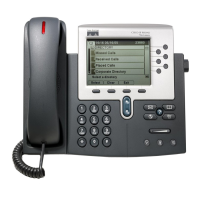Chapter 5 Configuring Network Settings on the Cisco IP Phone
Verifying Network Settings
5-8
Cisco IP Phone Administration Guide for Cisco CallManager 3.2, Cisco IP Phones 7960/7940/7910
78-10453-04
PC Port Disabled Indicates whether the PC port on the
phone is enabled or disabled. The port is
labeled “10/100 PC” on the back of the
phone and is used to connect a PC or
workstation to the phone so that they can
share a single network connection.
Cannot configure locally. Use
Cisco CallManager to modify.
SW Port Configuration Indicates the speed and duplex of the
switch port. Valid values are: A (auto
negotiate), 10H (10BASE-T/half
duplex), 10F (10BASE-T /full duplex),
100H (100BASE-T /half duplex), or
100F (100BASE-T /full duplex).
This parameter is configured at
the phone. See “Configuring the
SW Port” section on page 5-26.
PC Port Configuration Indicates the speed and duplex of the PC
port. Valid values are: A (auto
negotiate), 10H (10BASE-T /half
duplex), 10F (10BASE-T /full duplex),
100H (100BASE-T/half duplex), or
100F (100BASE-T/full duplex).
This parameter is configured at
the phone. See “Configuring the
PC Port” section on page 5-27.
TFTP Server 2 Displays the IP address of the backup
TFTP server. This server is used to
obtain configuration files and software
upgrades if the primary TFTP server is
unavailable.
See the “Assigning a Backup
TFTP Server” section on
page 5-24.
User Locale Identifies the locale associated with the
phone user. The user locale identifies a
set of detailed information to support
users, including language, font, date and
time formatting, and alphanumeric
keyboard text information.
Cannot configure locally. Use
Cisco CallManager to modify.
Table 5-1 Network Settings (continued)
Network Setting Description Usage Notes

